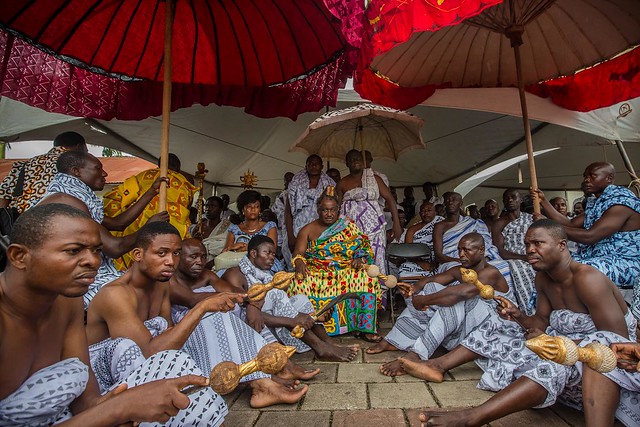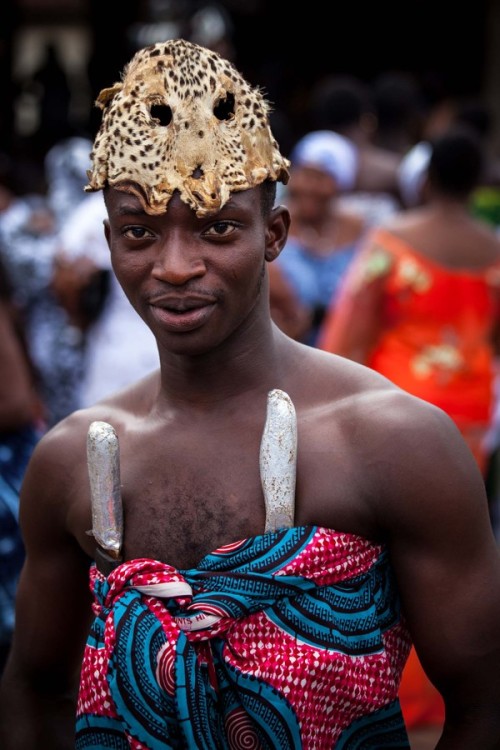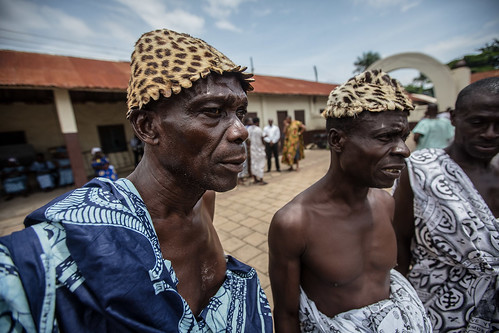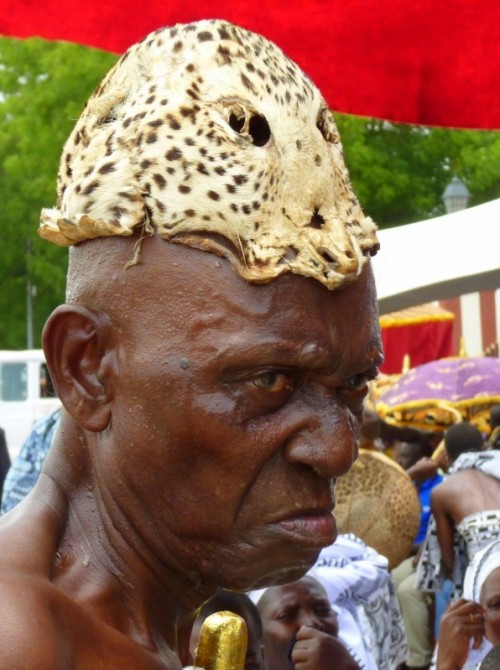Otumfuo Osei Tutu II, Asantehene (King of the Ashantis) sitting in state during Akwasidae festival of the Asante people, Kumasi, Ghana. Courtesy Anthony Pappone
Among the Akans, especially the Asantes and its allied groups like Denkyira, Akuapim, Akyem, Kwahu and others Akwasidae rituals and events are held every six weeks, honouring the ancestors and in the Ashanti region the Ashanti king.

Akwasidae celebration at Kumasi, Ashanti Region, Ghana, Courtesy imknowmadic2
All Asantes (Ashantis) as well as the Ashanti diaspora participate in this cultural festival. The Akwasidae Festival is next only in importance to the National Day celebrations. Akwasidae, according to the Ashanti cultural archive records is an ornate ceremony, commemorating the date that the Ashanti Golden Stool was magically brought down from heaven.
Asante girl in her Kente cloth dancing at Akwasidae festival at USA
The festival therefore features a golden stool alongside the central feature of attention, the Ashanti King, who is carried on a palanquin through the procession of Ashanti people who have come to pay homage to him. A visit to Kumasi during an Akwasidae celebration is an invitation for spectacle. A celebration which parades colourful canopies and umbrellas amongst fontonfrom, kete and mpintsin drummers, dancers, horn blowers and singers who perform in honour of their ancestral spirits.

Asante chief sitting in state during Akwasidae festival in Kumasi, Ghana. Courtesy Anthony Pappone
Many have heard of and witnessed Akwasidae festival of the Akans, but why the festival is called ‘Adae’ is little known to them. In Akan “adae” means rest place, so to bother you a bit, Akwadae is observed with a visit by the chief and some of his elders to the stool-house (Royal Mausoleum) where past chiefs had been buried to invoke their blessings for the people.
During such moments, a sheep is slaughtered and some of the blood sprinkled on the stools, which is accompanied by pouring libation amidst drumming. Akwasidae takes place in a 40-day cycle and in some years it is observed eight times and in others nine times.
King of the Asantes
Akan Calendar
The Akan annual calendar is divided into nine parts, each lasting approximately six weeks but varying between 40–42 days in a period; the celebration of this period is called the Adae Festival.

The Adae Festival has two celebration days: the Akwasidae Festival is celebrated on the final Sunday of the period, while the Awukudae Festival is celebrated on a Wednesday within the period. The Friday preceding 10 days to the Akwasidae is called the Fofie (meaning a ritual Friday). As the festival is always held on Sundays (Twi in Kwasidae), its recurrence could be after 40 or 42 days in accordance with the official Calendar of Ashanti. During the last Akwasidae of the year, which coincides with the Adae Kese Festival, special attention is given to make food offerings and donations for helping people. The festivals of Adae are not interchangeable as they were fixed from ancient times
Late Asantehene Otumfuo Opoku Ware II at Akwasidae festival
Celebration
To celebrate the Akwasidae, elderly women versed in traditional songs, would go to the palace continue, towards the evening of Saturday called Memenedae Dapaa, to sing, memorial songs until late in the night.

A gathering called Akom occurs, here drums are beaten and horns sounded to welcome the festival amidst dancing and merry making. In the early hours of the morning the drums are resumed to rouse the dead kings (nananom/nsamnafo ahenfo) and their elders (nsamanfo) from their sleep to partake in the festival.

Between 6 a.m. and 7 a.m., the queen mother with some elders would go to the palace of the paramount chief to greet and wish him well.
The paramount chief dressed in his mourning costume would ride in a palanquin to the mausoleum. With the exception of the paramount chief and the Banmuhene, no one is allowed to enter wearing sandals. What really happens inside the mausoleum?

In there, the stools are placed on a raised dais and the paramount chief, divisional chiefs and elders in order of precedence, go in and pay homage to the dead kings. Food in the form of mashed yam (eto) which has been prepared in the mausoleum is offered together with strong drinks to the dead kings.
A sheep is slaughtered and the blood which is drained into a bowl used to smear the stools with pieces of meat including the lungs placed on the stools while the fat is spread over the centre support of the stools.

The belief is that the blood revitalizes the stools and the ancestral spirits, and the lungs; a symbol of breath of life serves the purpose of giving new life to the stools. Concluding the ceremony in the mausoleum the paramount chief orders drinks to be served to all present who later depart leaving the stools and the ancestors to eat and drink what had been served them.
After the rituals in the morning, a ground durbar is held at the fore court of the Manhyia Palace where the Asantehene sits in state for his people to pay him homage.
As early as 7 a.m. preparations for the event had begun and by 10 a.m. the forecourt is filled to capacity by traditional rulers and the general public.
The arrival of the Asantehene at the durbar grounds is heralded by a retinue of courtiers led by a man carrying a brasspan containing talisman and herbs believed to drive away evil spirits.
Others carry the traditional sandals of silver and gold keys (the Nsafoahene).

The key, in folklore, signifies that when the Asantehene is out of the palace all doors are shut.
The Asantehene emerges holding a traditional sword in one hand and a whisk in another and dances to traditional music and steps out of the palanquin.
As the procession passes, he bows gently to the chiefs and other subjects to acknowledge their presence.
During Akwasidae, traditional rulers usually wear mourning clothes (Kuntunkuni) but with this year coinciding with the birthday of the occupant of the golden stool, they wore kente among others including Otumfuo himself who was dressed in a beautiful kente to match the occasion.
The gold ornaments he wore that day made it difficult for him at times to lift his hand.
Only the Bantamahene, Baffour Asare Owusu Amankwatia V, was dressed in a traditional mourning cloth. This, according to tradition followed the revolt and subsequent capture of the Bantamahene during the days of King Osei Tutu.
As he was freed he became the best ally of Osei Tutu and since then any occupant of the Bantama stool has to be in perpetual mourning.
Sitting in state, he combined the celebration of the Akwasidae and his birthday with pomp and pageantry characterized with traditional drumming and dancing which showcased the rich culture of Ashanti.
Role of Asante chiefs
In the Ashanti Region chiefs are highly visible and organized strongly hierarchically, from the Asantehene, king of Asante, at the top through the paramount chief (omanhene), divisional chief (ohene) and local village chief (odikro) to the clan or family head (abusua panin).
In the literature, the person and function of the chief are very much connected to traditional religion (Busia 1951; Hagan 2003; Rattray 1969; Ray 2003b). Busia wrote in 1951 that ancestor-worship was the basis of the chief’s authority as well as the sanction for morality in the community. The belief that the ancestors were the custodians of the laws and customs and that they punished those who infringed them with sickness or misfortune acted as a check on commoners and chiefs alike
(Busia 1951: 24, 136; Fortes 1962: 78. Cf Nukunya 1992: 128).
According to Rattray, the basis of the respect accorded to the chief is not only that the chief derives his power from the people, but also that the stools, skins and other symbols of office have a spiritual significance –the chief deriving his power from the ancestors and mediating between the people and the ancestors (Rattray 2003b: 7).

Ashanti chief during the Akwasidae the great celebration of the Ashanti in Kumasi.

























Photosource:Anthony Pappone